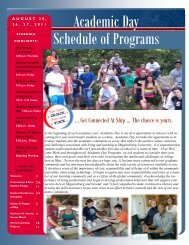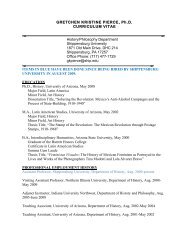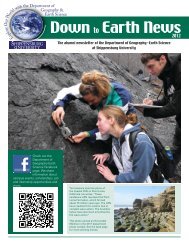Complete Issue - Shippensburg University
Complete Issue - Shippensburg University
Complete Issue - Shippensburg University
- No tags were found...
Create successful ePaper yourself
Turn your PDF publications into a flip-book with our unique Google optimized e-Paper software.
46 PROTEUS: A Journal of IdeasCleaning the Acropolis cavesAt nine o’clock in the morning on Saturday, April4, 1992, my mother and I arrive at the cave of theLife-giving Spring. 1 Eirinē Melas, who cleans theAcropolis caves on a monthly basis (Plate 3), tells usit is dedicated to Agioi (cf. Agios, i.e. Saint) Anargyroi,the patron saints of healing. 2 Eirinē has carried outthis task since the death of her husband who workedat the Acropolis. 3 Today, Eirinē’s daughter, twoother women, and a young man, Panagiotis, are alsopresent. He shares Eirinē’s religiosity, and, duringour stay, he presents several newspaper cuttings aboutthe “cave-churches.” 4 I always have regarded the twocaves as caves, but my informants always refer tothem as churches. With the exception of Panagiotis’participation, the key performers of the rituals inthe caves are women. They assertthat since childhood they havebeen brought to the Life-givingSpring to fetch holy water alongwith their mothers: “It has alwaysbeen like this.” A clear example ofhow Greek children are socialised,this is a common response toresearchers’ questions—a reaction thatunderscores the differences betweenthe perspective of many Greeks andthe more linear view of time andhistory shared by most WesternEuropeans. 5Eirinē tells me her arrival this daywas delayed by a visit to a church inMonastiraki. While she lights candlesand fetches water in the cave, we chatabout the annual festival dedicated tothe Life-giving Spring, scheduled inthe cave in approximately a month. Itis not clear whether the festival willbe celebrated this year due to twopractical problems, one the actualdate of the festival in 1992, coincideswith the celebration of Workers Day on May 1. Thesecond is the relationship between the new parish priestand the celebrants: According to Eirinē’s daughter,the young successor to the elderly priest in the nearbyByzantine Church resists participating at the festival,claiming it represents a pagan custom. During theconversation, I learn the previous year, the youngerpriest stated he was ill, suffering from a heart disease.“But, we don’t believe that,” added Maria.Despite the commonalities between Orthodoxpractices and popular traditions, tensions betweenthe two often come to the fore during celebrations. 6In 1991, the festival was observed only after Eirinē’sson invited a priest from the <strong>University</strong> of Piraeus toofficiate at the ceremony. Later that day, Eirinē andPanagiotis tell me they also plan to talk with the priestfrom Piraeus to ensure the ceremony will be held.Plate 2: The entrance to the SacredSpring, the Acropolis cave at Athens(author photograph).Eirinē plans to be here during the afternoon on May 1,but the service/mass will be in the morning, starting atapproximately 8:30.The cave is situated within the archaeologicalquarter of the Sanctuary of Asklepios, the ancienthealer of sickness, and today the entrance is securedwith bars and several padlocks. When they reach thecave this morning, everyone washes in the spring anddrinks the water. The two women assert the water ismiracle-working and healing. They have been hereregularly since childhood. They explain that among themany icons in the cave, the most holy represents thePanagia and the Child. In front of the icon, one of thewomen arranges a bunch of flowers (nasturtium). So,even if the cave is still dedicated to Agioi Anargyroi,in reality the Panagia is the one who gets the gifts.Similarly, while the icon of AgioiAnargyroi is still in the cave, thetamata (i.e. metal plaques depicting avow or request) are mainly dedicatedto the icons of the Panagia. Themost common offering is a silver- orgold-plated ex-voto representingthe person or limb that has alreadybeen, or is seeking to be, cured bythe icon in combination with thewater. Before she leaves the cave,the flower-arranging woman fills abottle with holy water, in keepingwith a tradition she learned fromher mother when she was five yearsold. The other woman also bringswith her a bunch of flowers. Sheonly “gives half of it to the icon inthis cave, because the other half isgoing to be offered to the icon of thePanagia in the other cave, where wewill go when we have finished here.” 7She states “this is the oldest churchin Greece, and Paul was preachinghere.” She lights the candles in frontof the icon, and she and her partner light the manyolive-oil lamps. All the devotees fill their bottles withwater, while saying “even if it is not raining, there willalways be water in the cave.”After a while, Eirinē fills a bucket with holy water,which we carry further up the rock into the other cavechurchalong with a candelabrum for votive candlesas well as a broom, some soap, and other objects.The church opens above the theatre of the ancientgod, Dionysus. This cave is dedicated to the PanagiaCrysospēliōtissa, or the Chapel of Our Lady of theGolden Cavern (Plate 4). 8 Within, Eirinē or someoneelse lights a lamp every evening.On the walls of the church are faded Byzantinepaintings, but the cave was also important for theancients. The two churches are from the fifth or thesixth century. In both churches we see a newspaper
















